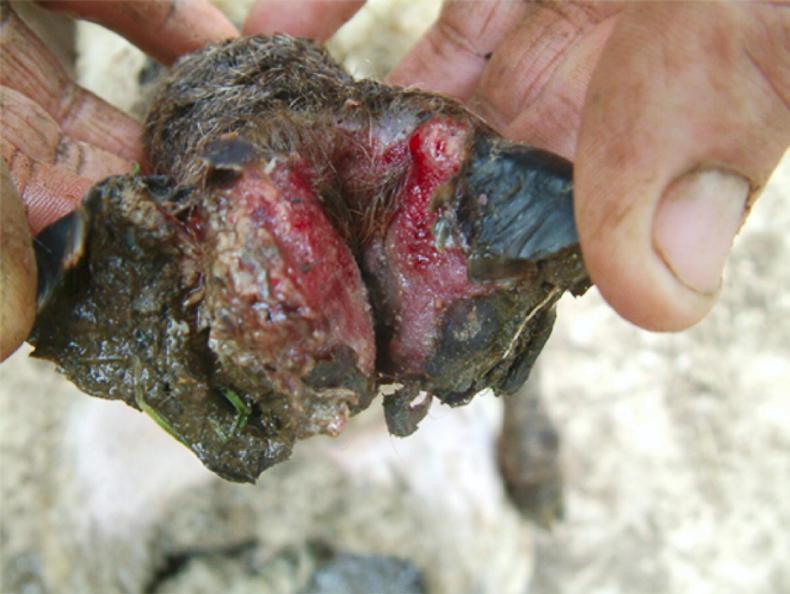Surveys conducted in the UK and Ireland have shown that conditions causing lameness are frequently misdiagnosed. Where this is the case, it can lead to incorrect treatments being adopted and symptoms failing to improve or getting progressively worse, despite the best efforts of the flock owner.
There are six main conditions causing lameness in sheep and these are detailed below. Each disease has different causative agents and, therefore, can require a different approach to treatment.
Previous recommendations saw routine foot paring being used as a management practice. This approach has changed. The advice now recommended is to tackle lameness in a flock health plan approach. Routine foot-paring should no longer be used and only sheep that require hoof trimming should be pared.
Identifying the cause of lameness is only one part of the solution. Tackling the problem effectively will also require you to calculate how serious the problem is. This can only be achieved by recording incidences of lameness, treatments, etc. Over time, these records will allow you to accurately see if the problem is improving or getting worse.
The target incidence of lameness in a flock should be about 5%. Once this level is achieved, preventative measures, such as foot-bathing at regular intervals, should be sufficient to control lameness at a low level. Grazing management and culling practices also have a role to play. Repeat offenders should be identified and recorded as it is usually these sheep that end up giving the majority of problems.
Where animals fail to recover, despite treatment, they should be culled from the flock and their offspring should not be retained as breeding replacements. Problem sheep should also be isolated from the flock and only allowed to rejoin once you are satisfied they are healthy and present no risk of spreading infection.
In the case with foot-rot, bacteria only survive on pasture for two weeks. Therefore, treatment followed by grazing on clean swards can greatly aid in reducing lameness issues.
Scald 
Caused by bacteria present in soil and faeces with infection occurring through damaged skin. Identifiable by a red/pink inflammation between the hoof claws with a white or grey paste-like scum on top. Treatment can include antibiotic sprays, antibiotic injections and foot-bathing. Where sheep are left untreated and become infected with a second bacteria called D nodosus, then the condition can progress to foot-rot.Footrot
Foot-rot occurs following scald and is caused by bacteria known as Dichelobacter nodosus. The bacteria can survive on pasture for up to two weeks. Infection risk and rate of disease spreading is heightened in mild weather or at housing where bedding is warm and stocking rates are high. Its symptoms are grey-coloured scum/pus between the hoof horns that also exhibits a characteristic strong odour. The hoof horn or hoof shell can start to separate away from the hoof. If the disease establishes, the hoof horn may become under-run, with the hoof horn lifting away from the hoof. The most effective treatment is injectable antibiotic. Footbathing is not an effective treatment but is an effective preventative/control measure.Prevention includes foot-bathing, culling persistent offenders, avoiding selecting replacements with a known history of disease and adequate quarantine procedures for bought-in stock.CODD 
CODD is often mistaken for foot-rot. The infection occurs at the top of the hoof or coronary band (area where hoof meets the leg). Like foot-rot, there is a grey pasty scum, plus there can be some bleeding, but there is no characteristic smell. In severe infections, it is not unusual for the hoof horn or hoof shell to fall off. The disease is very painful and will significantly affect performance. Veterinary advice should be sought if CODD is suspected. Injectable antibiotics or antibiotic foot-baths can be prescribed by vets. Toe granuloma or strawberry foot 
Toe granuloma gets the name ‘strawberry foot’ from its appearance. A piece of circular-shaped tissue grows out on the bottom of the hoof. The flesh is very sensitive to bleeding and it is painful. The most common cause of this condition is excessive hoof trimming where the soft part of the hoof tissue is excessively cut into and damaged (blood should not be drawn). The ailment is difficult to treat and frequently requires veterinary advice. Despite treatment, the condition might not resolve and affected sheep may need to be culled. Foot abscess
A foot abscess occurs where the hoof is damaged by thorns, stones, etc, entering the hoof. This can cause an infection resulting in the development of an abscess at the top of the hoof where it meets the coronary band. The condition is painful and sheep will be lame.Treatment can be carried out with injectable antibiotics. Shelly hoof (white line disease)
Shelly hoof is a condition of the hoof that results in the wall of the hoof separating and lifting away from the hoof. The animal may not appear very lame in normal conditions but may become lame if walking on uneven or hard ground or stone yards, etc. This can result from dirt, stones, etc, lodging between the hoof and the lifted hoof horn area. Infection develops and pus can form. This can burst out itself or careful trimming of the white line area can be carried out to release it. Unlike other lameness diseases, the cause is unknown, with hoof damage thought to be a contributing factor. Treatment usually includes paring away the lifted section of the hoof to expose a new layer underneath. Mineral/vitamin imbalances have been reported to be linked with the disease. Pictures: Courtesy of Jasmeet Kaler and Laura Green, University of Warwick






